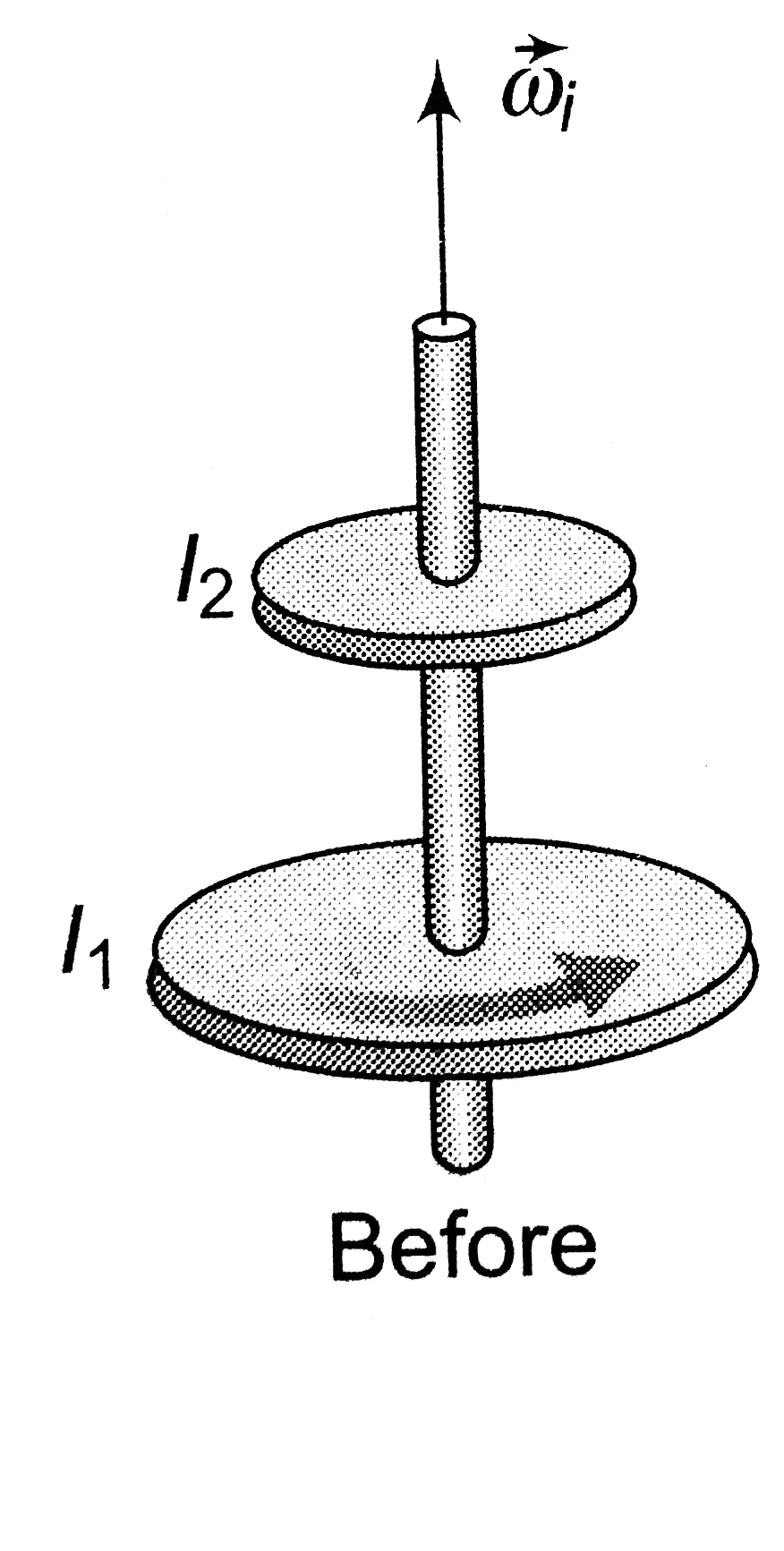A circular disk of moment of inertia It is rotating in a horizontal plane, about its symmetry axis, with a constant angular speed ωi Another disk of moment of inertia Ib is dropped coaxially onto the rotating disk. Initially the second disk has zero angular speed. Eventually both the disks rotate with a constant angular speed ωf The energy lost by the initially rotating disc to friction is
12IbIt(It+Ib)ω21
12I2b(It+Ib)ω21
12I2t(It+Ib)ω21
Ib−It(It+Ib)ω21
The correct Answer is:A
Itωi=(It+Ib)ωf,ωf=(I9t)ωi)It+Ib
Ki=12Itω2i
Kf=12(It+Ib)ω2f
loss of energy =Ki−Kf
=12Itω2i−12(ItωiIt+Ib)2(It+Ib)
=12Itω2i[1−ItIt+Ib]=12(IbItIb+It)ω2i
Topper's Solved these Questions
- ROTATIONAL MOTIONBOOK - ERRORLESSCHAPTER - ROTATIONAL MOTIONEXERCISE - NCERT BASED QUESTIONS (Rolling on Inclined Plane)
54 Videos
- ROTATIONAL MOTIONBOOK - ERRORLESSCHAPTER - ROTATIONAL MOTIONEXERCISE - PAST YEARS QUESTIONS
70 Videos
- ROTATIONAL MOTIONBOOK - ERRORLESSCHAPTER - ROTATIONAL MOTIONEXERCISE - NCERT BASED QUESTIONS (Angular Momentum)
52 Videos
- NEWTON'S LAWS OF MOTIONBOOK - ERRORLESSCHAPTER - NEWTON'S LAWS OF MOTIONEXERCISE - ASSERTION & REASON
18 Videos
- SIMPLE HARMONIC MOTIONBOOK - ERRORLESSCHAPTER - SIMPLE HARMONIC MOTIONEXERCISE - Assertion & Reason
15 Videos
Similar Questions
A circular disc of moment of inertia It is rotating in a horizontal plane about its symmetry axis with a constant angular velocity ωi. Another disc of moment of inertia Ib is dropped co-axially onto the rotating disc. Initially, the second disc has zero angular speed. Eventually, both the discs rotate with a constant angular speed ωf. Calculate the energy lost by the initially rotating disc due to friction.
View SolutionA disc of moment of inertia I1 is rotating freely with angular speed ω1 when another non-rotating disc of moment of inertia I2 is dropped on it. The two discs then rotate as one unit. Find the final angular speed.
View Solution
Knowledge Check
A disc of the moment of inertia 'l1' is rotating in horizontal plane about an axis passing through a centre and perpendicular to its plane with constant angular speed 'ω1' . Another disc of moment of inertia 'I2'. having zero angular speed is placed discs are rotating disc. Now, both the discs are rotating with constant angular speed 'ω2'. The energy lost by the initial rotating disc is
A12[l1+l2l1l2]ω21B12[l1l2l1−l2]ω21C12[l1−l2l1l2]ω21D12[l2l2l1+l2]ω21A disc of moment of inertia I1 is rotating freely with angular speed ω1 when another non-rotating disc of moment of inertia I2 is dropped on it. The two discs then rotate as one unit. Find the final angular speed.
AI1ω1I2BI2ω1I2+I2CI1ω2I1+I2D(I1+I2)I2ω1A disk with moment of inertia I1 rotates about frictionless, vertical axle with angular speed ωi A second disk, this one having moment of inertia I2 and initial not rotating, drops onto the first disk (Fig.) Because of friction between the surfaces, the two eventually reach the same angular speed ωf. The value of ωf is.
 .AI1+I2I1ωiBI1I1+I2ωiCI1+I2I2ωiDI1I2ωi
.AI1+I2I1ωiBI1I1+I2ωiCI1+I2I2ωiDI1I2ωi
A circular disc of mass M and radius R is rotating about its axis with angular speed If about another stationary disc having radius ω1.
R2 and same mass M is dropped co- axially on to the rotating disc. Gradually both discs attain constant angular speed ω2. The energy lost in the process is p% of the initial energy . Value of p is ........
View SolutionA disc with moment of inertiaI1, is rotating with an angular velocity ω1 about a fixed axis. Another coaxial disc with moment of inertia I2, which is at rest is gently placed on the first disc along the axis. Due to friction discs slips against each other and after some time both disc start rotating with a common angular velocity. Find this common angular velocity.
View SolutionA thin uniform circular disc of mass M and radius R is rotating in a horizontal plane about an axis passing through its centre and perpendicular to the plane with angular velocity ω. Another disc of same mass but half the radius is gently placed over it coaxially. The angular speed ofthe composite disc will be:
View SolutionA thin circular disk of radius R is uniformly charged with density σ>0 per unit area.The disk rotates about its axis with a uniform angular speed ω.The magnetic moment of the disk is :
View SolutionA hollow sphere partly filled with water has moment of inertia I when it is rotating about its own axis at an angular velocity ω. If its angular velocity is doubled then its moment of inertia becomes
View Solution
